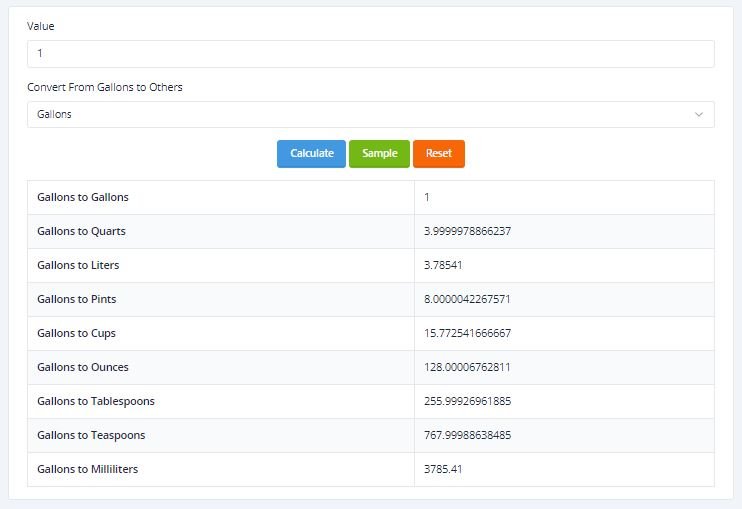Volume Converter
The Ultimate Guide to Volume Conversion: How to Convert Measurements Effectively
In today's fast-paced world, the need to convert various units of measurement is a common occurrence. Whether you're a chef trying to adjust a recipe, an engineer working with different unit systems, or simply someone curious about the volume of your favorite beverage, understanding volume conversion is a valuable skill. In this comprehensive guide, we'll explore everything you need to know about volume conversion, from the basics to advanced techniques. So, grab your thinking cap and let's dive into the world of volume conversion!
Understanding the Basics of Volume
Volume is the amount of space occupied by an object or substance. It's often measured in units such as milliliters (mL), liters (L), fluid ounces (fl oz), pints, quarts, and gallons, depending on your geographical location. Understanding the basics of volume is crucial before diving into volume conversion.
The Importance of Volume Conversion
Volume conversion is essential in various fields, including cooking, science, engineering, and everyday life. It allows us to work with different units seamlessly, ensuring accuracy and precision in our calculations.
Common Volume Units
Before we proceed, let's familiarize ourselves with some common volume units:
- Milliliters (mL): A metric unit, often used for small volumes.
- Liters (L): A metric unit, commonly used for larger volumes.
- Fluid Ounces (fl oz): A unit commonly used in the United States and a few other countries.
- Pints, Quarts, and Gallons: Imperial units predominantly used in the United States and the United Kingdom.
How to Convert Between Milliliters and Liters
Converting between milliliters and liters is a fundamental volume conversion. To convert milliliters to liters, divide the number of milliliters by 1000. For example, 5000 mL is equal to 5 liters.
Converting Fluid Ounces to Milliliters
When working with fluid ounces and milliliters, it's essential to know the conversion factor: 1 fluid ounce (fl oz) equals approximately 29.5735 milliliters (mL). You can use this factor to convert between the two units effortlessly.
Pints, Quarts, and Gallons: Conversion Made Easy
In the United States and some other countries, you'll frequently encounter pints (pt), quarts (qt), and gallons (gal) as units of volume. Here's a quick guide to converting between them:
- 1 gallon (gal) equals 4 quarts (qt).
- 1 quart (qt) equals 2 pints (pt).
---------------------------------------------------------------------------------------------------------------------------------------------------------------------------------------------------------------------------------
Here are some common volume conversion formulas:
-
Cubic Centimeters to Milliliters (cc to mL):
- 1 cubic centimeter (cc) is equivalent to 1 milliliter (mL).
-
Milliliters to Cubic Centimeters (mL to cc):
- 1 milliliter (mL) is equal to 1 cubic centimeter (cc).
-
Milliliters to Liters (mL to L):
- To convert milliliters to liters, divide the number of milliliters by 1000.
- Formula: L = mL / 1000
-
Liters to Milliliters (L to mL):
- To convert liters to milliliters, multiply the number of liters by 1000.
- Formula: mL = L * 1000
-
Fluid Ounces to Milliliters (fl oz to mL):
- 1 fluid ounce (fl oz) is approximately equal to 29.5735 milliliters (mL).
- Formula: mL = fl oz * 29.5735
-
Milliliters to Fluid Ounces (mL to fl oz):
- To convert milliliters to fluid ounces, divide the number of milliliters by 29.5735.
- Formula: fl oz = mL / 29.5735
-
Gallons to Quarts (gal to qt):
- 1 gallon (gal) is equal to 4 quarts (qt).
- Formula: qt = gal * 4
-
Quarts to Gallons (qt to gal):
- To convert quarts to gallons, divide the number of quarts by 4.
- Formula: gal = qt / 4
-
Pints to Quarts (pt to qt):
- 1 pint (pt) is equal to 0.5 quarts (qt).
- Formula: qt = pt * 0.5
-
Quarts to Pints (qt to pt):
- To convert quarts to pints, multiply the number of quarts by 2.
- Formula: pt = qt * 2
These formulas should help you perform basic volume conversions between common units. Keep in mind that there are many other units of volume used in different contexts, so you may encounter additional conversion factors depending on your specific needs.
---------------------------------------------------------------------------------------------------------------------------------------------------------------------------------------------------------------------------------
Volume Conversion in the Scientific World
In the scientific realm, accurate measurements are paramount. Scientists frequently work with various units of volume, making volume conversion an integral part of their daily routines. It ensures that experiments and observations are consistent and reproducible.
Advanced Volume Conversion Techniques
For more complex volume conversion scenarios, such as converting between units with varying conversion factors, it's helpful to use online conversion tools or dedicated software. These tools can handle intricate calculations with ease.
Frequently Asked Questions (FAQs)
-
Q: Can I convert between metric and imperial volume units? A: Yes, you can convert between metric (e.g., milliliters) and imperial (e.g., fluid ounces) volume units using appropriate conversion factors.
-
Q: Are there mobile apps for volume conversion? A: Absolutely! Many mobile apps are designed for volume conversion, making it incredibly convenient for users on the go.
-
Q: Is volume conversion the same as mass conversion? A: No, volume conversion deals with the space occupied by an object, while mass conversion focuses on the weight of an object.
-
Q: How do I convert between cubic meters and liters? A: To convert between cubic meters (m³) and liters (L), multiply the number of cubic meters by 1000.
-
Q: Where can I find accurate conversion factors for less common units? A: Scientific reference books and reputable online sources often provide accurate conversion factors for less common units.
Conclusion
Volume conversion is a valuable skill that empowers individuals in various fields. Whether you're a cook, scientist, or simply someone interested in understanding the world around you, mastering volume conversion will prove indispensable. So, go ahead and explore the world of volume conversion with confidence!













